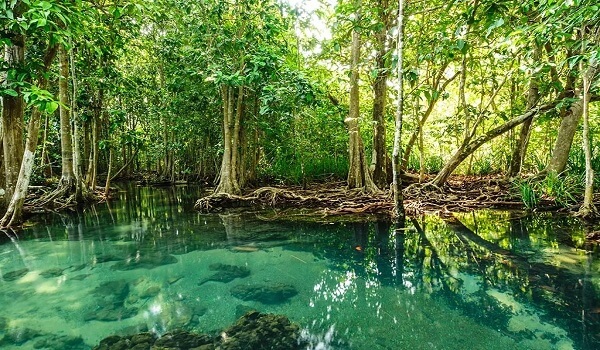International Day for the Conservation of the Mangrove Ecosystem, West Bengal, which is home to approximately 40% of India’s mangrove forests, unveiled plans to establish a dedicated ‘Mangrove Cell’ to streamline mangrove management efforts.
Status of Mangroves in India
- Mangroves are a unique type of coastal ecosystem found in tropical and subtropical regions. They are dense forests of salt-tolerant trees and shrubs that thrive in intertidal zones, where land meets the sea.
- These ecosystems are characterized by their ability to withstand harsh conditions, such as saline water, tidal fluctuations, and muddy, oxygen-poor soils.
- Mangroves exhibit Viviparity mode of reproduction, where seeds germinate within the tree before falling to the ground. This is an adaptive mechanism to overcome the challenge of germination in saline water.
- Some mangrove species secrete excess salt through their leaves, while others block the absorption of salt at their roots.
- Mangrove plants have special roots like prop roots and pneumatophores, which help impede water flow and provide support in the challenging tidal environment.
Mangrove Cover in India
- According to the Indian State Forest Report 2021, Mangrove cover in India is 4992 sq. Km which is 0.15% of the country’s total geographical area.
- Sundarbans in West Bengal are the largest mangrove forest regions in the world. It is listed as a UNESCO World Heritage Site.
- Besides the Sundarbans, the Andamans region, the Kachchh and Jamnagar areas in Gujarat too have substantial mangrove cover.
Significance
- Biodiversity Conservation: Mangroves provide a unique habitat for a wide variety of plant and animal species, serving as breeding, nursery, and feeding grounds for numerous marine and terrestrial organisms.For example, sundarban hosts the Royal Bengal tiger, Irrawady Dolphin, Rhesus macaque, Leopard cats, Small Indian civet.
- Coastal Protection: Mangroves act as natural buffers against coastal erosion, storm surges, and tsunamis.Their dense root systems and tangled network of prop roots stabilize shorelines and reduce the impact of waves and currents.During hurricanes and cyclones, mangroves can absorb and dissipate a significant amount of energy, protecting inland areas and human settlements from devastating damage.
- Carbon Sequestration: Mangroves are highly efficient carbon sinks, sequestering large amounts of carbon dioxide from the atmosphere and storing it in their biomass and sediments.
- Fisheries and Livelihoods: Mangroves support fisheries by providing nursery areas for fish and shellfish, enhancing fishery productivity and contributing to livelihood and local food security.
- Water Quality Improvement: Mangroves act as natural filters, trapping and removing pollutants and excess nutrients from coastal waters before they reach the open ocean.Their role in purifying water contributes to the health of marine ecosystems and helps maintain the balance of fragile coastal ecosystems.
- Tourism and Recreation: Mangroves offer recreational opportunities such as eco-tourism, birdwatching, kayaking, and nature-based activities, which can promote sustainable economic growth for local communities.

